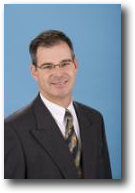ChEMS Professor Receives NASA Tech Briefs Award
 James C. Earthman, Ph.D., professor of chemical engineering and materials science and biomedical engineering, was given the 2010 NASA Tech Briefs Award for contributing a technical article to NASA Tech Briefs magazine that highlights an innovation or technology developed for the Ames Research Center with NASA support. The article, “Optical Structural Health Monitoring Device,” describes the Compact Low-Power Device for In-situ Fatigue Monitoring, a miniaturized laser scanning device capable of detecting fatigue crack precursors on an aircraft, developed by Earthman and collaborators Benjamin D. Buckner, Ph.D., and Vladimir B. Markov, Ph.D., at MetroLaser, Inc. (Irvine, Calif.). This wireless device is so small and lightweight that several of them can be mounted at critical locations in a single airframe. With this network of detectors, it will be possible to monitor the structural health of an aircraft during, as well as between, flights. This research is currently supported by a Small Business Innovation Research (SBIR) grant from the Defense Advanced Research Projects Agency (DARPA).
James C. Earthman, Ph.D., professor of chemical engineering and materials science and biomedical engineering, was given the 2010 NASA Tech Briefs Award for contributing a technical article to NASA Tech Briefs magazine that highlights an innovation or technology developed for the Ames Research Center with NASA support. The article, “Optical Structural Health Monitoring Device,” describes the Compact Low-Power Device for In-situ Fatigue Monitoring, a miniaturized laser scanning device capable of detecting fatigue crack precursors on an aircraft, developed by Earthman and collaborators Benjamin D. Buckner, Ph.D., and Vladimir B. Markov, Ph.D., at MetroLaser, Inc. (Irvine, Calif.). This wireless device is so small and lightweight that several of them can be mounted at critical locations in a single airframe. With this network of detectors, it will be possible to monitor the structural health of an aircraft during, as well as between, flights. This research is currently supported by a Small Business Innovation Research (SBIR) grant from the Defense Advanced Research Projects Agency (DARPA).
Earthman's research activities include studies of broad range of deformation and damage mechanisms in both model and advanced materials. His work also involves the development and use of computer-based techniques for determining the damping characteristics of biomaterials and mechanical biocompatibility, the corrosion behavior of metals exposed to living cells, and the nondestructive characterization of surface defects in situ. He received a B.S. degree from Rice University, and M.S. and Ph.D. degrees from Stanford University, all in materials science and engineering, and has authored and co-authored more than 100 research publications, including two chapters on biomechanics and materials for tissue engineering. He is an inventor on five patents, two international patents, and three pending patents, and has also served as editor for two books in the fields of materials science and biomedical engineering.
